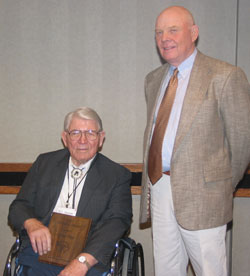George Chiga Receives BIF Pioneer Award
The Beef Improvement Federation (BIF) honored George Chiga with the Pioneer Award at the 35th Annual Meeting and Research Symposium in Lexington, Kentucky, on May 30, 2003. The award recognizes individuals who have made lasting contributions to the improvement of beef cattle.

George Chiga (left) receives the Pioneer Award from Richard McClung, 2003 BIF President.
|
George C. Chiga of Tulsa, Oklahoma, was selected to receive the Beef Improvement Federation Pioneer Award. George represents a true American success story, and embodies one of the true pioneers in our industry’s performance movement.
George’s parents emigrated from Hungary to Saskatchewan, Canada where George was born in 1913. George grew up on the family homestead, but to ease the financial burden on the family, he left home at an early age to make a living on his own as best he could. His many jobs included cleaning bricks piecemeal, cutting ice, working on the highway, cooking in mining camps, and serving as a bouncer.
While working in Flin Flon, Manitoba during the height of the depression, George developed an interest in boxing and wrestling; an interest that would lead to higher education and new opportunities. George represented Canada as a heavyweight wrestler in the 1936 Olympics hosted in Germany where his talents were recognized and he was offered a spot on the Oklahoma State University wrestling team.
Although economics had prohibited George from completing the tenth grade, he attended Oklahoma State University where he played football and wrestled, and was honored as a Phi Kappa Phi student. During this time George met Vernice, who would become his wife, business partner and office manager in the years to come. He graduated with a degree in Animal Science with a deep interest in genetics and animal breeding. Enrolling in graduate school for a Master’s degree he completed his thesis project on the inbreeding and outbreeding of swine. From this work George became a disciple of line and inbreeding which characterized his breeding philosophy throughout his career.
To gain U.S. citizenship, George volunteered for the service during World War II. After the war he returned to Oklahoma and taught Agriculture at Guthrie, Oklahoma, to World War II veterans under the G.I. Bill of Rights. During this time, George enrolled at the Oklahoma City Law School, passed the bar and began to practice law throughout his professional lifetime.
Both George and Vernice dreamed of owning cows, and in 1949 they selected Red Angus in which to invest because: 1) Angus was an already established breed with known strengths and weakness; and 2) he could afford the red cattle since they were barred from registry at the American Angus Association. By 1954, they had collected 17 cows, and from this humble beginning, George’s operation grew to the point that he controlled the marketing and breeding of over 1,000 cows. Many people believe this was the first use of cooperators, as we know it today.
The Red Angus Association of America’s formation meeting was held in 1954. At the meeting, George and Waldo Forbes worked for three days and nights to develop the rules and regulations that would result in the industry’s first breed performance program. Other innovations included mandatory reporting of weaning weights, the first to collect yearling weights, open A.I., and barring of nurse cows. At this meeting Waldo was elected President and George Vice President. George assumed the Presidency in 1956 upon the untimely death of Waldo and served in this position until 1960.
George explained, "The establishment of Red Angus was more than an accumulation of numbers. It was dreaming about a new approach – performance testing was a part of Red Angus from its inception." To put this in perspective, "The first Red Angus registry certificate had a place on it for recording adjusted weaning weights – a full two years before PRI (Performance Registry International) was organized and adopted the 205 day adjustments used today." Wasting no time, Red Angus adopted the 205 day standard one week after the PRI meeting. George explained, "Progressiveness was the key character of the Red Angus breed… This initial progressive spirit has survived and expanded"
George’s impact on Red Angus and the early performance movement are incalculable. In the Red Angus breed, 95 percent of today’s cattle descend from George’s "Chiefline" breeding. Above all George is an individualist who stuck with, promoted and expanded the use of performance testing during the time when people looked upon them as "just a bunch of harmless screwballs."
Perhaps George’s life is best summed up by Robert de Baca’s book Courageous Cattlemen when he explained, "Chiga is an entrepreneur. He capitalized on his opportunities. He rose above the limitations that were his given the economics of the times and family means into which he was born. He succeeded while doing the things at which others were failing. He knew how to be a friend. And he believes strongly in society’s giving a helping hand to other survivors who have a right and a desire to share in the American dream."

